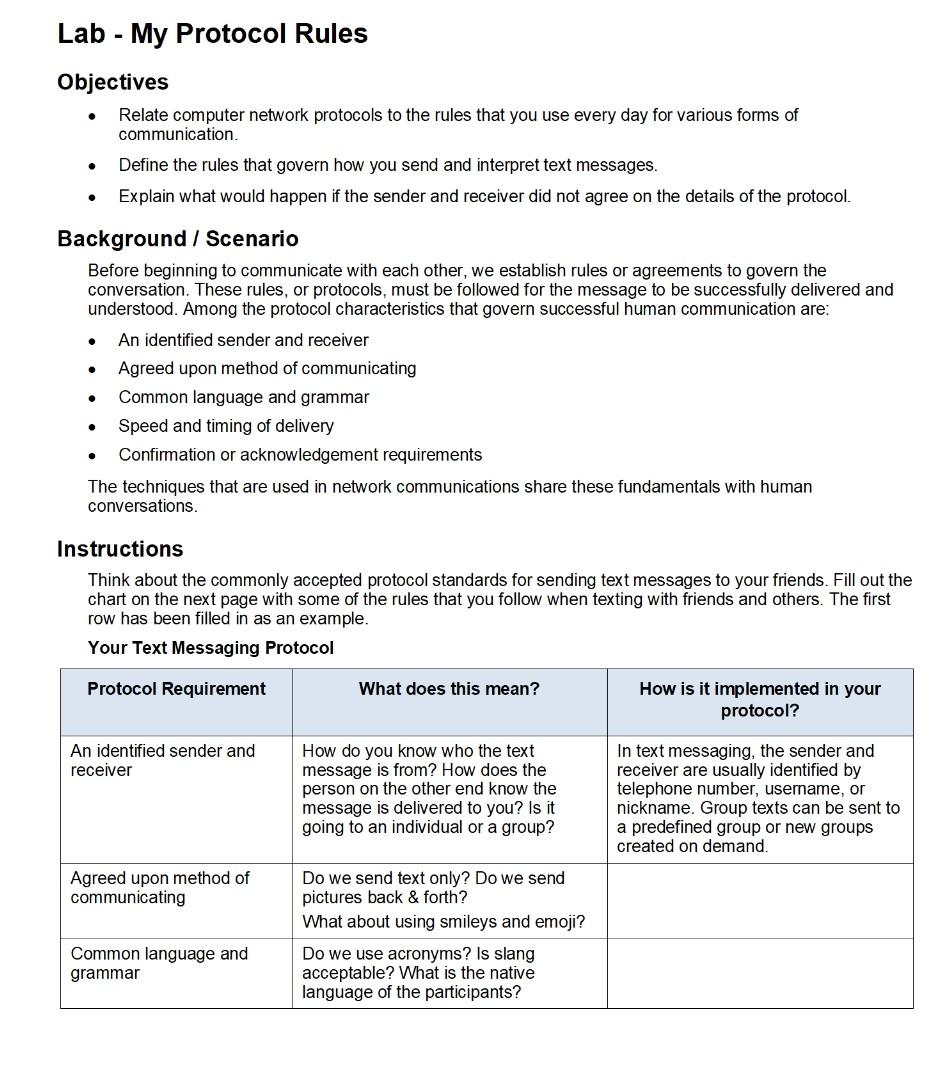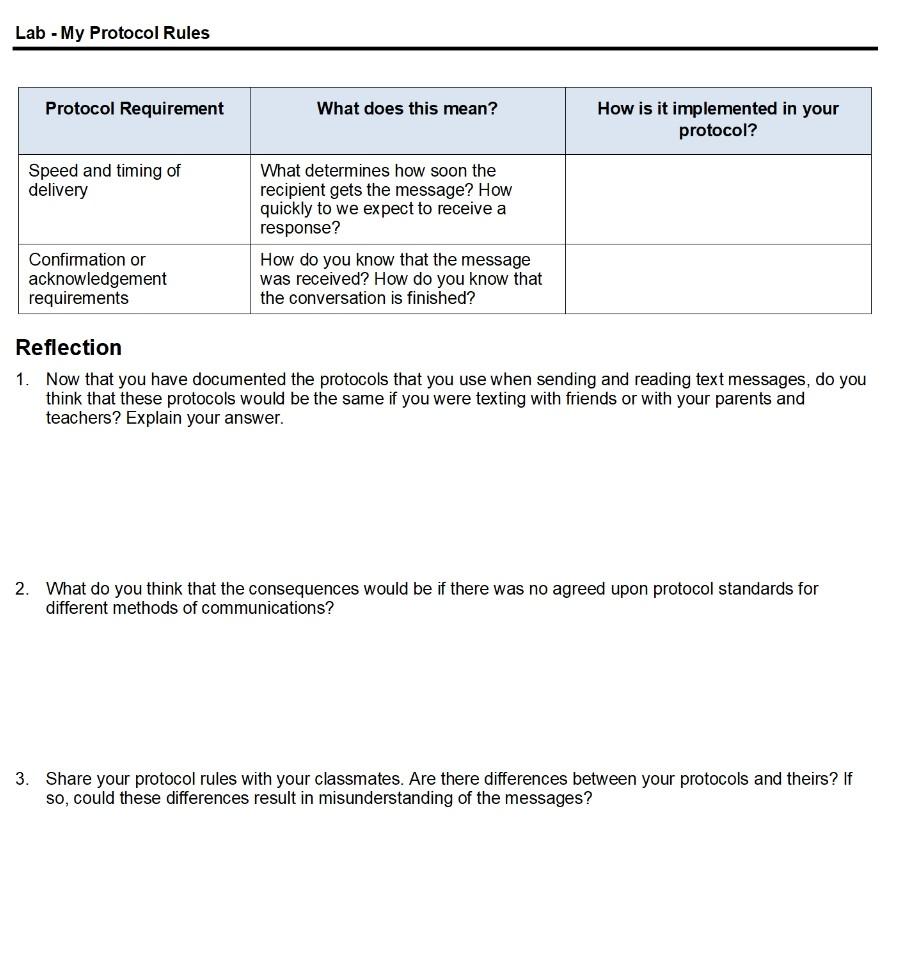Answered step by step
Verified Expert Solution
Question
1 Approved Answer
ANSWER KEY IS TO HELP WITH QUESTIONS Lab - My Protocol Rules - Objectives Relate computer network protocols to the rules that you use every



ANSWER KEY IS TO HELP WITH QUESTIONS
Lab - My Protocol Rules - Objectives Relate computer network protocols to the rules that you use every day for various forms of communication. . . Define the rules that govern how you send and interpret text messages. Explain what would happen if the sender and receiver did not agree on the details of the protocol. . Background / Scenario Before beginning to communicate with each other, we establish rules or agreements to govern the conversation. These rules, or protocols, must be followed for the message to be successfully delivered and understood. Among the protocol characteristics that govern successful human communication are: An identified sender and receiver Agreed upon method of communicating Common language and grammar Speed and timing of delivery Confirmation or acknowledgement requirements The techniques that are used in network communications share these fundamentals with human conversations. . C . Instructions Think about the commonly accepted protocol standards for sending text messages to your friends. Fill out the chart on the next page with some of the rules that you follow when texting with friends and others. The first row has been filled in as an example. Your Text Messaging Protocol Protocol Requirement What does this mean? How is it implemented in your protocol? An identified sender and receiver How do you know who the text message is from? How does the person on the other end know the message is delivered to you? Is it going to an individual or a group? In text messaging, the sender and receiver are usually identified by telephone number, username, or nickname. Group texts can be sent to a predefined group or new groups created on demand. Agreed upon method of communicating Do we send text only? Do we send pictures back & forth? What about using smileys and emoji? Do we use acronyms? Is slang acceptable? What is the native language of the participants? Common language and grammar Lab - My Protocol Rules Protocol Requirement What does this mean? How is it implemented in your protocol? Speed and timing of delivery What determines how soon the recipient gets the message? How quickly to we expect to receive a response? How do you know that the message was received? How do you know that the conversation is finished? Confirmation or acknowledgement requirements Reflection 1. Now that you have documented the protocols that you use when sending and reading text messages, do you think that these protocols would be the same if you were texting with friends or with your parents and teachers? Explain your answer. 2. What do you think that the consequences would be if there was no agreed upon protocol standards for different methods of communications? 3. Share your protocol rules with your classmates. Are there differences between your protocols and theirs? If So, could these differences result in misunderstanding of the messages? Lab - My Protocol Rules Answer Key Your Text Messaging Protocol Protocol Requirement What does this mean? How is it implemented in your protocol? An identified sender and receiver How do you know who the text message is from? How does the person on the other end know the message is delivered to you? Is it going to an individual or a group? Agreed upon method of communicating Do we send text only? Do we send pictures back & forth? What about using smileys and emoji? Common language and grammar In text messaging, the sender and receiver are usually identified by telephone number, username, or nickname. Group texts can be sent to a predefined group or new groups created on demand. It can be a mix of text, pictures, smileys and emoji. Depending on your device and mobile OS, you may even be able to send videos. The sender and receiver can use acronyms and languages that are understood by both sides. The speed of the delivery depends on the speed of the network and amount delay and latency in the network. A response is received when the recipient sends a response. The intended recipient sends a response and the recipient indicates the end of the conversation. Do we use acronyms? Is slang acceptable? What is the native language of the participants? What determines how soon the recipient gets the message? How quickly to we expect to receive a response? Speed and timing of delivery Confirmation or acknowledgement requirements How do you know that the message was received? How do you know that the conversation is finished? Reflection 4. Now that you have documented the protocols that you use when sending and reading text messages, do you think that these protocols would be the same if you were texting with friends or with your parents and teachers? Explain your answer. The protocols would be the same, but the data will probably be different. 5. What do you think that the consequences would be if there was no agreed upon protocol standards for different methods of communications? If there were no protocol standards, you would not be able to communicate because it would be similar to speaking different languages between senders and receivers. 6. Share your protocol rules with your classmates. Are there differences between your protocols and theirs? If So, could these differences result in misunderstanding of the messages? If the protocols are not compatible, there could result in misunderstanding of the messagesStep by Step Solution
There are 3 Steps involved in it
Step: 1

Get Instant Access to Expert-Tailored Solutions
See step-by-step solutions with expert insights and AI powered tools for academic success
Step: 2

Step: 3

Ace Your Homework with AI
Get the answers you need in no time with our AI-driven, step-by-step assistance
Get Started


